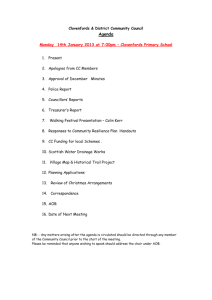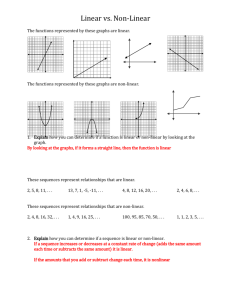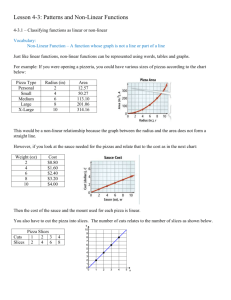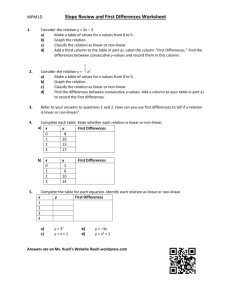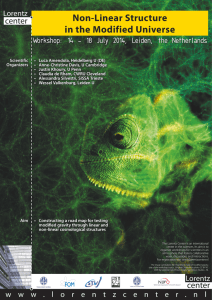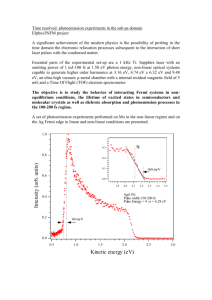Supplementary Information (doc 140K)
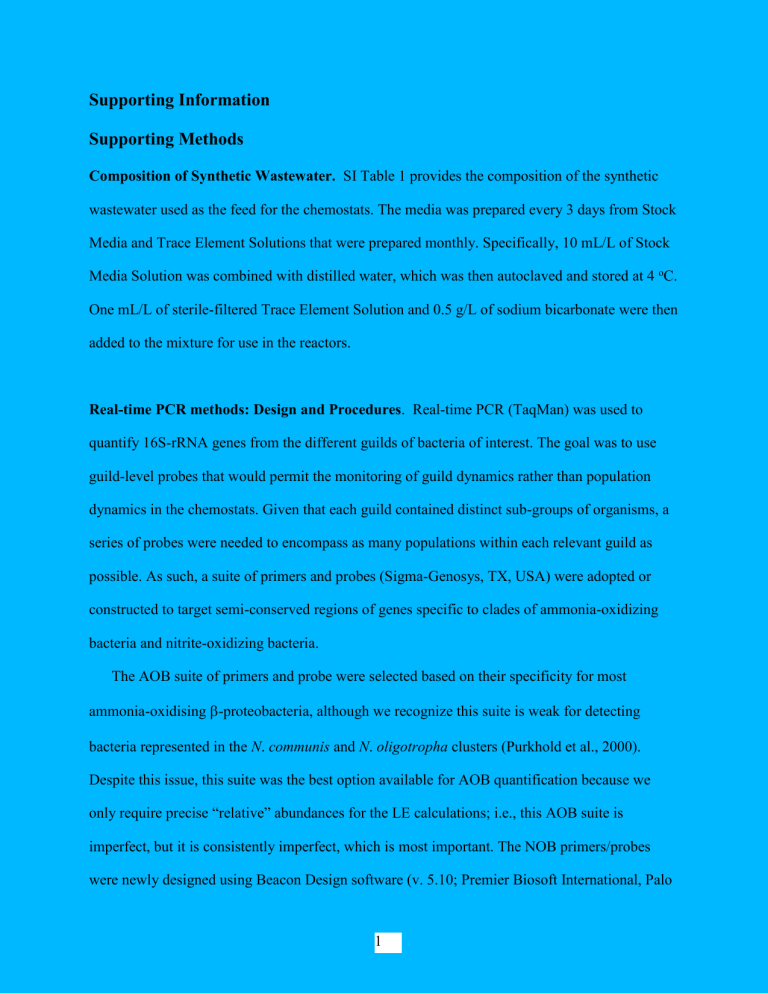
Supporting Information
Supporting Methods
Composition of Synthetic Wastewater. SI Table 1 provides the composition of the synthetic wastewater used as the feed for the chemostats. The media was prepared every 3 days from Stock
Media and Trace Element Solutions that were prepared monthly. Specifically, 10 mL/L of Stock
Media Solution was combined with distilled water, which was then autoclaved and stored at 4 o C.
One mL/L of sterile-filtered Trace Element Solution and 0.5 g/L of sodium bicarbonate were then added to the mixture for use in the reactors.
Real-time PCR methods: Design and Procedures . Real-time PCR (TaqMan) was used to quantify 16S-rRNA genes from the different guilds of bacteria of interest. The goal was to use guild-level probes that would permit the monitoring of guild dynamics rather than population dynamics in the chemostats. Given that each guild contained distinct sub-groups of organisms, a series of probes were needed to encompass as many populations within each relevant guild as possible. As such, a suite of primers and probes (Sigma-Genosys, TX, USA) were adopted or constructed to target semi-conserved regions of genes specific to clades of ammonia-oxidizing bacteria and nitrite-oxidizing bacteria.
The AOB suite of primers and probe were selected based on their specificity for most ammonia-oxidising
-proteobacteria, although we recognize this suite is weak for detecting bacteria represented in the N .
communis and N .
oligotropha clusters (Purkhold et al., 2000).
Despite this issue, this suite was the best option available for AOB quantification because we only require precise “relative” abundances for the LE calculations; i.e., this AOB suite is imperfect, but it is consistently imperfect, which is most important. The NOB primers/probes were newly designed using Beacon Design software (v. 5.10; Premier Biosoft International, Palo
1
Alto, CA, USA). A single TaqMan® primer/probe set was designed to detect Nitrobacter spp., whereas another set was designed for Nitrospira spp. that specifically detected desired products, rather than PCR artifacts (e.g., primer dimers). For the quantification of both AOB and NOB,
DNA template (2 µL), appropriate primers (15 pmol) and probes (6.25 pmol) were combined with iQ Supermix PCR reagent (BioRad, Hercules, CA, USA) to create 25 µL reaction volumes.
Reactions were then performed using a BioRad iCycler with an iCycler iQ fluorescence detector and software v. 2.3 (BioRad). Temperature cycle was 95 o C (10 min), and 40 cycles of 94 o C (20 sec), anneal temperature (Table 1) for 1 min, and 72 o C (40 sec).
Real-time PCR methods: Specificities . Specificities of AOB, NOB, and “total bacteria” primer/probe sets were checked using BLASTn tool (http://www.ncbi.nlm.nih.gov/blast/) and
Probe-Match program in the RDP Database (http://rdp.cme.msu.edu/; last accessed 5/2007) to compare matches among “full-length” (>1200 base) sequences. The specificity for the total bacteria suite of primers and probe ranged from 46.6% to 78.1% for no mismatches and 74.8% to
98.7% for one mismatch (note that the stringencies may have been affected with the low annealing temperature of 50 o C). Specificities for the AOB suite are reported elsewhere (Koops et al., 2003). The Nitrobacter spp. primers/probe matched 96-100% sequences with little or no binding to non-targeted sequences, wheresas Nitrospira spp. analysis consisted of genus-specific reverse primer and Taqman® probe, and a less specific forward primer. Together, they targeted
~85% of known sequences in the Nitrospira genus.
Real-time PCR methods: Precision . The variability of analysis was examined by extracting 8 replicates of a common sample and comparing its coefficients of variation (usually around 17%).
The presence of inhibitory substances in the sample matrix were checked by spiking the samples
2
with known amounts of template and comparing differences in concentration threshold values
(C
T
) between the matrix and controls (always less than one cycle difference). PCR efficiencies were further examined by comparing serial dilutions of selected samples (those with high concentrations of DNA) and plasmid controls. Correlation coefficients were more than 0.99 for all calibration curves, and sample log gene abundances (except those below detection limits) were within the linear range of the calibration curve.
Bacterial Biomass Conversions.
Although only relatively precise abundances are required for the LE calculations (and biomass conversation is not really needed), bacterial gene abundance were converted to biomass equivalents for comparisons with protozoa data. As such, these conversions were performed using existing data from the literature, including assumed gene copy numbers/cell, cell biovolumes, and allometric biomass conversion factors. Specifically, rRNA operon per cell was assumed to be 4.3 for “total bacteria” (Klappenbach et al
. 2001) and 1.0 for
AOB (Klappenbach et al . 2001; GenBank #NC008344 and #NC007614, both unpublished;
#NC004757, Chain et al ., 2003), Nitrospira spp. (assumed), and Nitrobacter spp. (GenBank
#NC007964, unpublished; #NC007406, Starkenberg et al. 2006). Biovolumes were assumed to be: total bacteria, 0.7 μm 3 (Posch et al .
, 2001); AOB, 1.57 μm 3 (Koops et al., 2003); Nitrobacter sp., 0.58 μm 3 (Bergey et al .
, 1994); and Nitrospira sp., 0.28 μm 3 (Abeliovich, 2001). Allometric biomass conversions were assumed to be 125-288 fg/ μm 3 (Loferer-Krössbacher et al .
, 1998).
Demonstrating Non-linear Determinism in the Time Series. Given that guild dynamics must follow a non-linear deterministic model as a pre-condition for chaos to exist within the time series, two additional tests were performed to show that non-linear determinism described the data better than a linear stochastic model with error. In the first test, linear and non-linear
3
Volterra-Wiener expansions were fitted to the data (Barahona & Poon, 1996) and the average error from each fit was calculated in-sample. When the error from the non-linear model was smaller than that of the linear model we concluded that there was likely a visible non-linear component to the data. In the second test, error in the non-linear Volterra-Wiener model was used as a statistic in a surrogate data test using Matlab and TISEAN software (Hegger et al, 1999).
As background, the Volterra-Wiener series of order d , with system memory
, is defined as follows (Barahona & Poon, 1996):
ˆ
( n )
h
0
l d
1 j
1
1 j
2
1
j l
1 h ( j
1
, , j l
) x ( n
j
1
) x ( n
j l
) (1).
For
1 , , 6 the order-1 series (linear) and order-2 series (non-linear), respectively, were fitted to guild abundance time-series in a least squares sense, minimizing the root mean square (rms) error e , where e
2
(
, d )
n
N
x n
x
ˆ
( n )
2 n
N
R
x n
x
2
. The parameter
serves the same function as the embedding dimension, m , in the LE calculations, and its range was chosen to be consistent with LE calculations. For each d , with
{ 1 , , 6 } , e
ˆ
(
) was chosen to minimize
C ( r )
log( e )
r
N
, with r being the number of polynomial terms in the series model, and N =
104 the length of the time-series. For d = 2, the model was truncated to obtain the best fit with the smallest number of non-linear terms.
In-sample rms error in the non-linear Volterra-Wiener model was also used in surrogate testing of the null hypothesis that abundance data is generated by a linear process with Gaussian inputs. Polished, amplitude-adjusted-Fourier-transform (AAFT) surrogates were generated from the Fourier power spectrum of abundance data for all guilds in each reactor. Surrogate time-series share linear properties of abundance data while non-linear properties are randomized. This method is described in Schreiber and Schmitz (2000) and was implemented using TISEAN
4
software (Hegger et al, 1999) ( http://www.mpipks-dresden.mpg.de/~tisean/TISEAN_2.1
).
Specifically, the Volterra-Wiener series of order 2, x
ˆ
( n )
h
0
j
1 h
1
( j ) x ( n
j )
j
1 k
1 h
2
( j , k ) x ( n
j ) x ( n
k ) , was fitted without truncation to abundance time-series and to surrogate time series; e
ˆ was determined on each series in the manner described above. A one-sided test was then carried out: if abundance data had lowest ranking of e
ˆ (i.e. smallest error) in an e
ˆ -distribution over 19 AAFT surrogates, the null hypothesis was rejected with a significance of 95%.
Examination of Noise and Variability in Time-series Data. Two approaches were used to characterize noise and fluctuations in the time series: a modified Pimm-Redfearn analysis of variability and detrended fluctuation analysis (DFA). Pimm and Redfearn (1988) previously showed “reddening” (or “pinkness”) in population density time series by comparing the standard deviations of log-transformed values taken from the time series at different segment (census) lengths. Specifically, as one calculates variability over a longer period of time, values would increase if there is an underlying dynamical behavior in the time series. However, Rohani et al
(2004) suggested that all possible segments of a time series with each census length be calculated, thus creating pseudo-replication; from those multiple values, a statistical average could be calculated, which was assessed here.
DFA was performed based on the method presented by Peng et al (1995) using a modified algorithm provided in PhysioToolkit (Goldberger et al, 2000). The data series was integrated and divided into boxes of equal length, and a least-squares line fitted to the data. The average fluctuation (i.e., rms) of the detrended time series is determined as a function of box size. A
5
scaling exponent (α) can be calculated from log-log plot of the results, which reflects random versus non-random patterns.
Supporting Results
Reactor Operation Period. The chemostats were operated for over 300 days in the experiment; however, only 207 days of data were used in the analysis. The first 30 days were operated as batch and then fill-and-draw units (which are quite different than later chemostat operations), and those data were not used. Further, three hydraulic retention times of data after the reactors were switched to continuous-flow operations were also not used (~ 30 days based on the 0.1 d -1 reactor) because this is the customary period allowed for acclimation after changes in system operations. Finally, the last 30 days operating data were not used because a mistake was made making the media, which destabilized the systems at around day 275 to 285. Specifically, on day
285, nitrification in both the 0.83 and 0.3 d -1 chemostats suddenly ceased and could not be recovered despite one month of additional effort. Given that we could not identify exactly when the mistake was made, we conservatively chose an “end” date well before the suspected error.
This stop date decision was somewhat arbitrary, but was made prior to data analysis so that we did not bias any subsequent guild or performance analyses.
Measures of Non-linearity, Variability, and “Noise”. The in-sample rms errors of a linear
Volterra-Wiener model and a non-linear Volterra-Wiener model are tabulated for all guilds to 4 significant figures in SI Table 2. The non-linear error is smaller ( d opt
= 2 ) for all chemostats and all guilds, which implies that the time-series data is fitted better by a non-linear rather than a linear process.
6
SI Table 3 presents rankings of error ‘ e’
measured on abundance data in a distribution over
19 surrogates, where e is the rms error in a non-linear Volterra-Wiener model. As background, if the abundance data error has the smallest ranking (i.e., one) in the distribution then the null hypothesis that abundance data is generated by a linear process with noisy inputs is rejected with a significance of 95%. SI Table 3 indicates that the most frequently-occurring rank for guild data is one. Although conclusions cannot be made universally to a 95% confidence level, results clearly show that our time-series data has the smallest or near the smallest ranking, which is strong confirmation of non-linearity given the short, noisy nature of the time-series.
Modified Pimm-Redfearn tests on each time series indicates the data in each series was
“pink”, meaning that long-term trends dominated the data, rather than just short-term random events (i.e., white noise). SI Figure 1 shows that AOB and NOB variability became greater as census lengths increased, but also reached an asymptotic limit for census lengths greater than about 32 days. The same general pattern was observed for other guilds (total bacteria and protozoa are not shown). The only exception was in the 0.1 day -1 reactor for NOB, which reached a limit at a census length of only 10 days.
Dominance of longer term patterns was also confirmed by DFA, where α
AOB
were 1.1, 0.8 and 0.9 for the 0.1, 0.3 and 0.83 day -1 chemostats, respectively. In this analysis, values greater than 0.5 but less than 1 suggest long-range power-law correlations (“red”-shifted patterns). All values for α
NOB
also were ~ 1, except for the 0.1 day -1 reactor, which reported α
NOB
~ 0.7, suggesting more randomness, but this does not imply significantly “random.” Finally, α
Total Bacteria and α
Protozoa
were in the range 1-1.1 for the 0.1 and 0.83 day -1 chemostats, whereas values from the 0.3 day -1 unit were slightly lower, 0.8 to 0.9, but (again) were not significantly random.
References
7
Abeliovich A (2001) The Nitrite oxidizing bacteria. In: Dworkin M, et al.
(Eds) The Prokaryotes:
An Evolving Electronic Resource for the Microbial Community, Springer Verlag , New
York
Barahona M & Poon C-S (1996) Detection of nonlinear dynamics in short, noisy times series.
Nature 381 : 215-217.Bergey DH, Holt JG, Krieg NR & Sneath PHA (1994) Bergey's
Manual of Determinative Bacteriology . Lippincott Williams & Wilkins , Baltimore, MD,
USA
Chain P, Lamerdin J, Larimer F, Regala W, Lao V, Land M, et al.
(2003) Complete genome sequence of the ammonia-oxidizing bacterium and obligate chemolithoautotroph
Nitrosomonas europa . J. Bacteriol . 185 : 2759-2773.
Goldberger AL, Amaral LAN, Glass L, Hausdorff JM, Ivanov PC, Mark RG, et al . (2000)
PhysioBank, PhysioToolkit, and PhysioNet – Components of a new research resource for complex physiologic signals. Circulation 101 , e215-e220.
Harms G, Layton AC, Dionisi HM, Gregory IR, Garrett VM, Hawkins SA , et al.
(2003) Realtime PCR quantification of nitrifying bacteria in a municipal wastewater treatment plant.
Environ Sci Technol 37 : 343-351
Hegger R, Kantz H & Schreiber T (1999) Practical implementation of nonlinear time series methods: The TISEAN package. Chaos 9 : 413-435.
Hermansson A & Lindgren PE (2001) Quantification of ammonia-oxidizing bacteria in arable soil by real-time PCR. Appl Environ Microbiol 67 : 972-976
Klappenbach JA, Saxman PR, Cole JR & Schmidt TM (2001) rrndb: the Ribosomal RNA Operon
Copy Number Database. Nucl Acids Res 29 : 181-184
Koops H-P, Purkhold U, Pommerening-Röser A, Timmermann G & Wagner M (2003) The
Lithoautotrophic ammonia oxidizing bacteria. In: Dworkin M, et al.
(Eds) The
8
Prokaryotes: An Evolving Electronic Resource for the Microbial Community, Springer-
Verlag , New York
Kowalchuk GA, Stephen JR, DeBoer W, Prosser JI, Embley TM & Woldendorp JW (1997)
Analysis of ammonia-oxidizing bacteria of the beta subdivision of the class
Proteobacteria in coastal sand dunes by denaturing gradient gel electrophoresis and sequencing of PCR-amplified 16S ribosomal DNA fragments. Appl Environ Microbiol
63 : 1489-1497
Loferer-Krössbacher M, Klima J & Psenner R (1998) Determination of bacterial cell dry mass by transmission electron microscopy and densitometric image analysis. Appl Environ
Microbiol 64 : 688-694
Peng C-K, Havlin S, Stanley HE & Goldberger AL (1995) Quantification of scaling exponents and crossover phenomena in nonstationary heartbeat time-series Chaos 5 : 82-87
Pimm SL & Redfearn A (1988) The variability of population-densities. Nature 334 : 613-614
Posch T, Loferer-Krossbacher M, Gao G, Alfreider A, Pernthaler J & Psenner R (2001) Precision of bacterioplankton biomass determination: a comparison of two fluorescent dyes, and of allometric and linear volume-to-carbon conversion factors. Aq Microb Ecol 25 : 55-63
Purkhold U, Pommerening-Roser A, Juretschko S, Schmid MC, Koops, H-P, & Wagner, M.
(2000) Phylogeny of all recognized species of ammonia oxidizers based on comparative
16S rRNA and amoA sequence analysis: Implications for molecular diversity surveys..
Appl Environ Microbiol 66 : 5368-5382
Rohani P, Miramontes O & Keeling MJ. (2004) The colour of noise in short ecological time series data. Math Med Biol 21 : 63-72
Schreiber T & Schmitz A. (2000) Surrogate time series. Physica D 142 : 346-382.
9
Starkenberg SR, Chain PS, Sayaverda-Soto LA, Hauser L, Land ML, et al.
(2006) Genome sequence of the chemolithoautrophic nitrite-oxidizing bacterium Nitrobacter winogradskyi
Nb-225. Appl Environ Microbiol 72 : 2050-2063
10
SI Table 1.
Stock solutions for preparing the synthetic wastewater media.
100x Stock Media Solution
(add 10 mL to 1000 mL volume DI water, autoclave, and store at 4 o C)
Peptone
“Lab Lemco” powder (Oxoid)
Yeast extract
Urea
(NH
4
)
2
SO
4
K
2
HPO
4
KH
2
PO
4
CaCl
2
·6H
2
O
MgSO
4
·7H
2
O
1000x Trace Element Solution
(sterile filter and add 1 mL to 1000 mL
Media Solution after autoclaving)
FeCl
3
·6H
2
O
H
3
BO
3
CuSO
4
·5H
2
O
KI
MnCl
2
·4H
2
O
NaMoO
4
·6H
2
O
ZnSO
4
·7H
2
O
CoCl
2
·6H
2
O
EDTA
Concentrated hydrochloric acid
(g/L-stock)
32.0
19.0
3.0
3.0
6.7
1.4
1.1
0.4
0.2
(g/L-stock)
0.75
0.075
0.015
0.09
0.06
0.03
0.06
0.075
0.5
1 mL
11
SI Table 2.
In-sample rms errors of a linear Volterra-Wiener Model versus and a non-linear
Volterra-Wiener model.
Dilution Rate e
0.1 d -1 r
e
0.33 d -1 r
e
0.83 d -1 r
0.5148 6 5 0.586 6 5 0.3358 3 2 Total bacteria Linear
AOB
Non-linear
Linear
0.2080
0.5775
28
6
6
5
0.217
0.349
27
6
6
5
0.1322
0.5780
28
2
6
1
NOB
Non-linear 0.3320 24 6 0.147 28 6 0.1071 26 6
Linear 0.8699 4 3 0.463 7 6 0.4906 4 3
Non-linear 0.6986 11 5 0.167 28 6 0.0882 28 6
Protozoa Linear 0.3979 7 6 0.382 6 5 0.4659 2 1
Non-linear 0.2865 28 6 0.265 28 6 0.3530 25 6
SI Table 3. e -rankings for guild abundance data among chemostats with surrogate series.
Dilution Rate
Total bacteria
AOB
NOB
Protozoa
0.1 d -1
1
4
2
6
0.33 d -1
1
1
1
7
0.83 d -1
1
1
2
8
12
SI Figure 1. Variability versus census length for AOB and NOB guild abundances for the three chemostats.
AOB
1.0
0.9
0.8
0.7
0.6
0.5
0.4
0.3
0.2
0.1
0.0
0
0.10 day-1
0.33 day-1
0.83 day-1
50 100 150 census interval
200 250
NOB
1.8
1.6
1.4
1.2
1.0
0.8
0.6
0.4
0.2
0.0
0 50 100 150 census interval
200 250
0.10 day-1
0.33 day-1
0.83 day-1
13
